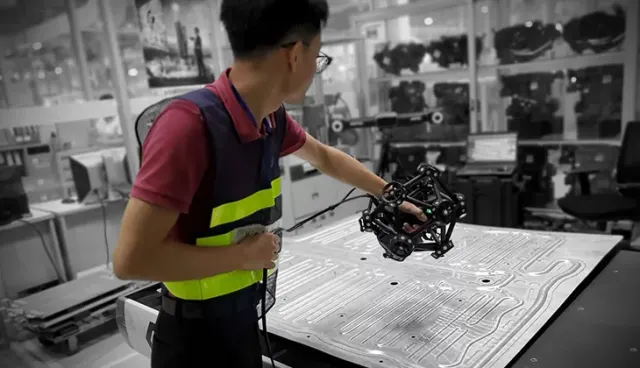Enhancing Aluminum Sheet Surface Inspection with AI-Powered Technologies
In industries where aluminum sheets are a fundamental material, ensuring their quality is crucial. From construction to automotive and packaging, aluminum sheets serve as the backbone for various applications. However, the process of inspecting these sheets for surface defects, irregularities, and inconsistencies poses significant challenges, particularly when operating at high speeds.
Traditional inspection methods are often insufficient for modern manufacturing standards, where even microscopic defects can compromise the product’s integrity and functionality. This is where AI-powered inspection systems step in, offering unparalleled accuracy, speed, and efficiency. This article explores the challenges of aluminum sheet inspection, the role of artificial intelligence, and how modern technologies are transforming quality control processes.
Why Aluminum Sheet Surface Inspection Matters
The quality of aluminum sheets directly impacts the performance and durability of the end product. Surface defects such as scratches, dents, cracks, and contamination can compromise the material’s integrity, leading to costly production errors, safety hazards, and customer dissatisfaction.
Common defects in aluminum sheets include:
• Scratches and Scuffs: Caused by handling or improper processing.
• Dents: Resulting from uneven pressure during rolling or transportation.
• Pinholes: Microscopic perforations that weaken the material.
• Surface Contamination: Presence of oils, dirt, or residues from the manufacturing process.
• Laminate Defects: Issues arising during the application of protective or decorative films.
Identifying and addressing these defects early in the production cycle is essential for maintaining high standards of quality and reducing waste.
Challenges in Traditional Inspection Methods
Traditional inspection methods for aluminum sheets often rely on manual checks or basic optical tools. While these approaches have been the industry standard for decades, they come with significant limitations:
- Human Error: Manual inspections are prone to fatigue, inconsistency, and missed defects, particularly in high-speed production lines.
- Time-Consuming: Checking each sheet manually slows down production, increasing operational costs.
- Limited Detection Capabilities: Traditional tools may fail to detect microscopic defects or inconsistencies on wide or fast-moving sheets.
- Inefficiency at High Speeds: High-speed manufacturing processes require inspection systems that can keep up without compromising accuracy.
AI-Powered Inspection: Revolutionizing Quality Control
The integration of AI Software and machine vision has transformed aluminum sheet surface inspection, overcoming the limitations of traditional methods. These systems leverage advanced algorithms, high-resolution cameras, and real-time data processing to detect even the smallest surface defects at remarkable speeds.
How AI-Powered Surface Inspection Works
- Image Capture: High-resolution cameras capture detailed images of the aluminum sheet surfaces, even at high speeds.
- AI Algorithms: These images are analyzed using AI-powered algorithms capable of identifying defects such as scratches, pinholes, and contamination at a micron level.
- Real-Time Feedback: The system provides instant defect identification, classification, and reporting, enabling manufacturers to take immediate corrective actions.
- Data Analytics: Historical data is stored and analyzed for trend identification, helping manufacturers optimize their processes and prevent recurring issues.
Key Benefits of AI-Powered Aluminum Sheet Inspection
The adoption of AI-powered surface inspection systems offers numerous advantages:
1. Enhanced Accuracy
AI algorithms are capable of detecting micron-level defects that are invisible to the human eye. This ensures a higher level of precision and eliminates the risk of undetected flaws.
2. High-Speed Inspection
Unlike traditional methods, AI-powered systems can operate seamlessly at high speeds, ensuring quality control without slowing down production lines.
3. Consistency and Reliability
Automated systems eliminate the inconsistencies and errors associated with manual inspections, delivering consistent results across all production batches.
4. Reduced Costs
By identifying defects early in the manufacturing process, these systems help reduce material waste, rework, and downtime, leading to significant cost savings.
5. Comprehensive Defect Classification
AI systems can classify and categorize defects, providing valuable insights into the root causes and enabling manufacturers to address them proactively.
6. Scalable and Customizable
These systems can be tailored to meet the specific needs of different industries and applications, making them versatile and adaptable.
Applications of AI-Powered Aluminum Sheet Inspection
The versatility of AI-powered inspection systems makes them ideal for a wide range of industries where aluminum sheets are used:
- Automotive Industry Ensuring the surface quality of aluminum sheets used in car bodies, panels, and structural components.
- Aerospace Industry Detecting surface defects in lightweight aluminum components critical for aircraft performance.
- Packaging Industry Ensuring the integrity of aluminum sheets used for beverage cans, food packaging, and containers.
- Construction Industry Inspecting aluminum sheets used in roofing, cladding, and architectural elements.
- Electronics Industry Verifying the surface quality of aluminum sheets used in electronic casings and heat sinks.
Overcoming Industry Challenges with AI Solutions
AI-powered inspection systems address some of the most pressing challenges in aluminum sheet manufacturing:
1. Wide and Fast-Moving Sheets
Modern production lines produce aluminum sheets that are both wide and fast-moving, making manual inspection impractical. AI systems handle these challenges effortlessly, ensuring accurate inspections at scale.
2. Micron-Level Defects
Traditional tools struggle to detect microscopic defects that can impact the sheet’s functionality. AI algorithms excel in identifying these minute flaws, ensuring the highest quality standards.
3. High Volume Production
With the ability to operate continuously at high speeds, AI-powered systems are perfectly suited for high-volume production environments.
Future Trends in Aluminum Sheet Inspection
As AI and machine vision technologies continue to evolve, the future of aluminum sheet inspection looks promising. Key trends shaping the industry include:
- Integration with IoT AI systems integrated with IoT platforms enable real-time monitoring, remote diagnostics, and predictive maintenance.
- Edge Computing Edge computing allows data to be processed locally, reducing latency and enabling real-time defect detection.
- Advanced Analytics AI-powered analytics provide actionable insights into production trends, defect patterns, and process optimization.
- Sustainability Initiatives By minimizing waste and improving production efficiency, AI inspection systems contribute to sustainability efforts in manufacturing.
The demand for high-quality aluminum sheets in industries like automotive, aerospace, and packaging has made surface inspection a critical aspect of manufacturing. Traditional inspection methods are no longer sufficient to meet the growing need for precision, speed, and efficiency.
AI-powered inspection systems are transforming the way aluminum sheets are inspected, offering unparalleled accuracy, consistency, and scalability. By addressing the challenges of high-speed production, wide-sheet inspection, and micron-level defect detection, these systems are setting new benchmarks in quality control.
As industries continue to adopt AI and machine vision technologies, manufacturers can expect improved productivity, reduced costs, and enhanced product quality. The future of aluminum sheet surface inspection lies in harnessing the full potential of AI-driven solutions, ensuring that every sheet meets the highest standards of excellence.






